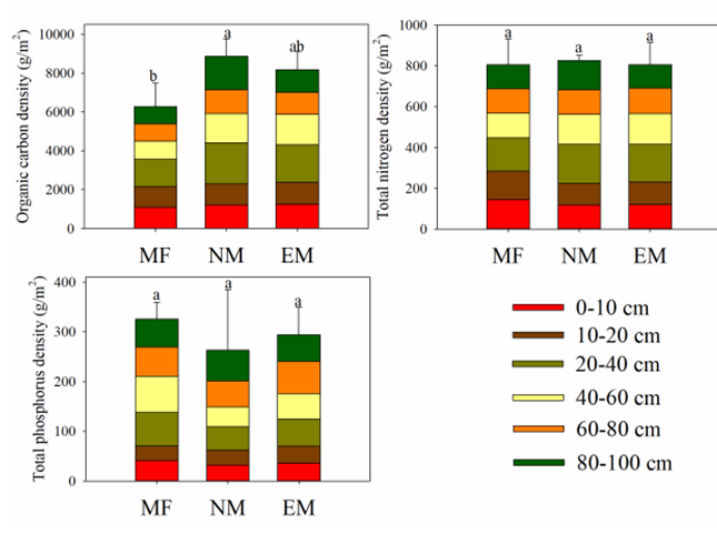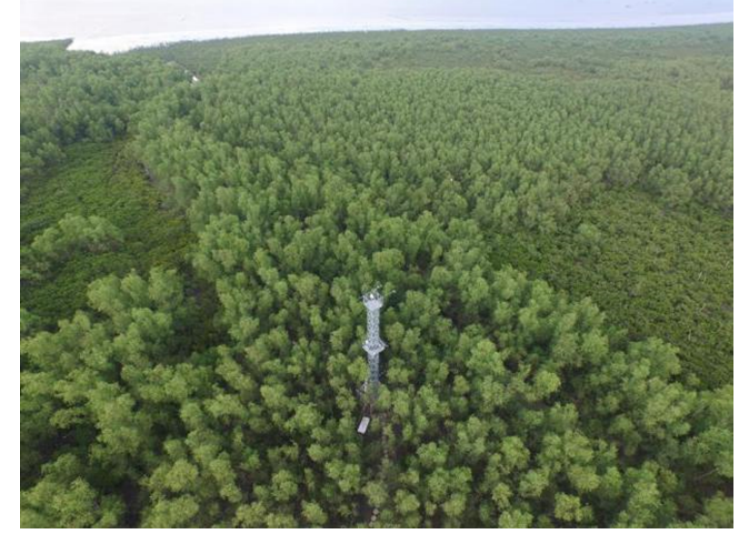Effects of Exotic Plants and Mangrove Remediation on Carbon Fixation in Wetlands
The fast growing exotic Sonneratia apetala had been widely used to restore the mangroves in China. Planted mangroves play important roles in enhancing carbon sequestration and nutrient storage. The contents and pools of soil organic carbon (SOC), total nitrogen (TN) and total phosphorus (TP) of simultaneously planted exotic S. apetala and native mixing mangrove (Avicennia marina, accompanied by Aegiceras corniculatum and Kandelia obovata) were quantified to evaluate the ecological restoration effects. Comparing with unvegetated mudflat, the colonization of mangrove can increase the SOC content within 60 cm and total nitrogen contents within 40 cm. No significant differences existed between S. apetala and native mangrove communities for the SOC, TN and TP contents. The restoration of mangrove forests enhanced the soil carbon stock relative to mudflat but significant differences existed only between native mangrove and mudflat. The TN and TP pools were not impacted by the plantation of mangroves. Therefore, plantation of S. apetala less than two decades did not show any advantages on the stocks of organic carbon and nutrients. The mixing native mangrove community should be recommended to enlarge the area of mangrove and enhance the carbon stock capability in the future.

Feng JX, Cui XW, Zhou J, Wang LM, Zhu XS, Lin GH. Effects of exotic and native mangrove forests plantation on soil organic carbon, nitrogen, and phosphorus contents and pools in Leizhou, China. Catena. 2019, 180: 1-7.
.
Background and Objectives: The rapid spread of invasive Spartina alterniflora Loisel. in the mangrove ecosystems of China was reduced using Sonneratia apetala Buch.-Ham. as an ecological replacement. Here, we studied the effects of invasion and ecological replacement using S. apetala on soil organic carbon fractions and stock on Qi’ao Island. Materials and Methods: Seven sites, including unvegetated mudflat and S. alterniflora, rehabilitated mangroves with different ages (one, six, and 10 years) and mature native Kandelia obovata Sheue, Liu, and Yong areas were selected in this study. Samples in the top 50 cm of soil were collected and then different fractions of organic carbon, including the total organic carbon (TOC), particulate organic carbon (POC), soil water dissolved carbon (DOC) and microbial biomass carbon (MBC), and the total carbon stock were measured and calculated. Results: The growth of S. alterniflora and mangroves significantly increased the soil TOC, POC, and MBC levels when compared to the mudflat. S. alterniflora had the highest soil DOC contents at 0–10 cm and 20–30 cm and the one-year restored mangroves had the highest MBC content. S. alterniflora and mangroves both had higher soil total carbon pools than the mudflat. Conclusions: The invasive S. alterniflora and young S. apetala forests had significantly lower soil TOC and POC contents and total organic carbon than the mature K. obovata on Qi’ao Island. These results indicate that ecological replacement methods can enhance long term carbon storage in Spartina-invaded ecosystems and native mangrove species are recommended.

Feng JX, Wang SG, Wang SJ, Ying R, Yin FM, Jiang L, Li ZF. Effects of invasive Spartina alterniflora Loisel. and subsequent ecological replacement by Sonneratia apetala Buch.-Ham. on soil organic carbon fractions and stock. Forests. 2019, 10(2), 171.
